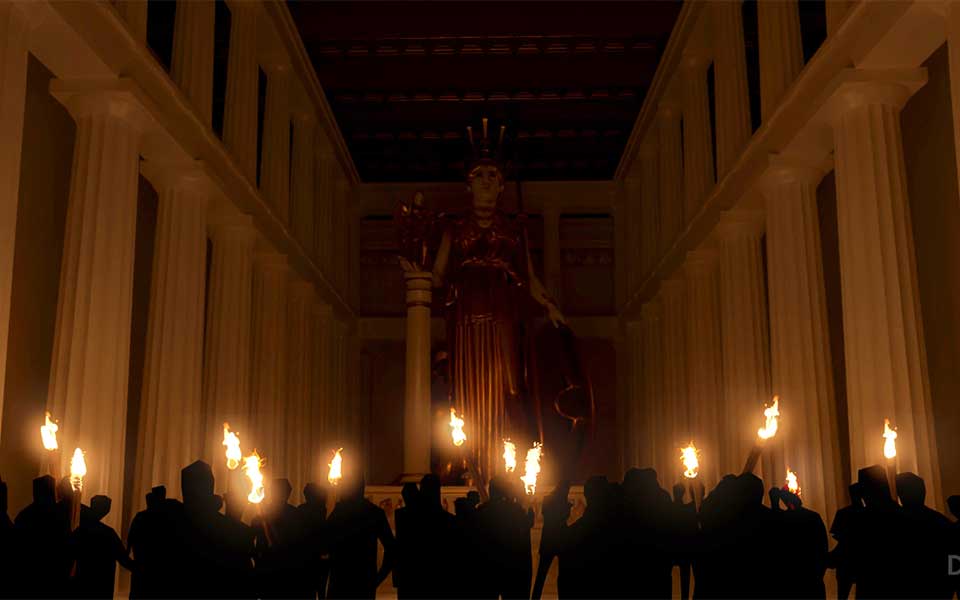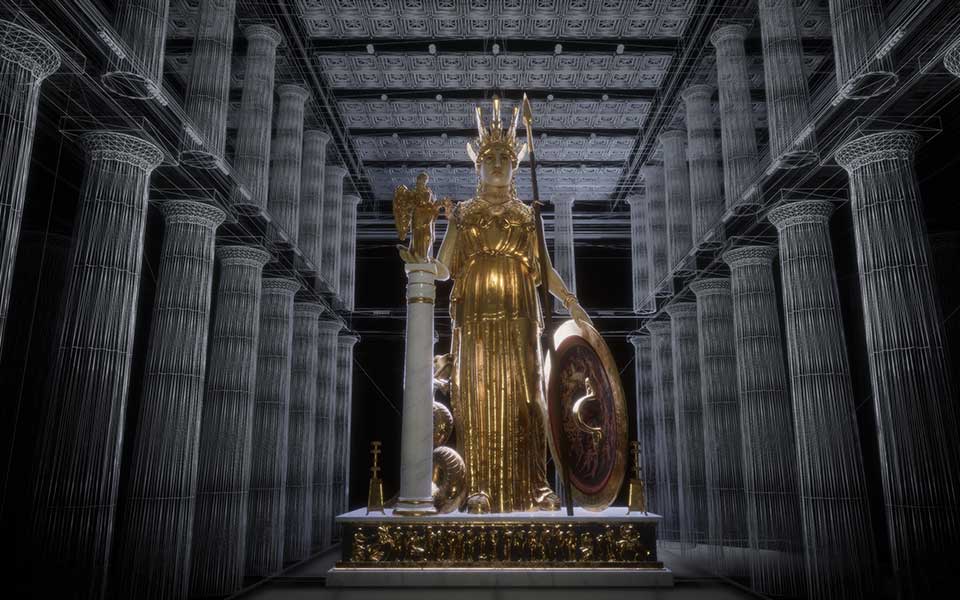A 3D reconstruction by Oxford researcher Juan de Lara recaptures the divine choreography of a Parthenon shaped by ancient sunlight. To find out more, I talked to him about imagination, the architecture of awe, and the continued relevance of this ancient wonder.
By Dimitris Athinakis | May 16th, 2025
Something stirs onscreen. What was once rubble and conjecture now shines –reconstructed, restored and reilluminated. The interior of the Parthenon appears: present, yet slightly uncanny. Shafts of filtered sunlight sweep across a colossal figure. Her ivory hands are half-lit, her gaze carved from shadow. Gold catches the light and marble breathes as incense drifts in the air. The goddess Athena does not emerge from the light, but from the darkness. Suddenly, the past feels less distant than we’ve been taught to believe – or to feel.
When Juan de Lara, a researcher and lecturer at the University of Oxford specializing in architectural visualization, set out to digitally reconstruct the Parthenon’s interior, he wasn’t looking to revive a ruin. He was chasing a sensation – a moment of luminous revelation, a ritual space woven from light and smoke. “I’ve long wondered what kind of emotional impact these temples would have had,” he says. “This project wasn’t about reconstructing the structure – it was about reconstructing the experience.”
 
De Lara’s study, “Illuminating the Parthenon in 3D, ” recently featured on the Cambridge University Press blog and in the peer-reviewed Annual of the British School at Athens, is a work of rare ambition: a digital rendering of how ancient Athenians might have encountered their most iconic temple – not as silent visitors, but as engaged worshipers moving through a space alive with divinity.
As de Lara explains, “the visual effect upon entering the Parthenon is one of dynamic reflectivity; the statue of Athena appears to emerge gradually from the surrounding darkness – a true epiphanic vision.”
 
Indeed, his work goes a step beyond conventional classical studies of the Acropolis. Rather than focus solely on structure, his project offers a multisensory revival of Athens’ most emblematic temple – one born from evidence, technology and imagination. At its core lies a rarely asked question in classical scholarship: what did it feel like to stand inside the Parthenon at its religious height, when its rituals were alive, and its guardian goddess, Athena Parthenos, gleamed in gold and ivory – the very materials that gave her form?
 Cutaway view of the cella of the Parthenon, with the area for the pool shown in dark grey.
Cutaway view of the cella of the Parthenon, with the area for the pool shown in dark grey. © Juan de Lara
Cutaway view of the cella of the Parthenon, with the area for the pool shown in dark grey.© Juan de Lara
 A 3D reconstruction of the chryselephantine statue of Athena.
A 3D reconstruction of the chryselephantine statue of Athena. © Juan de Lara
A 3D reconstruction of the chryselephantine statue of Athena.© Juan de Lara
Giving substance to the divine
For de Lara, the Parthenon functioned as a machine for metaphysical perception, carefully calibrated to produce awe through architecture, optics and the alchemy of materials. The spectacle of Athena was not only devotional – it was astonishing.
“The Parthenon must have had a tremendous impact,” he says. “These were the special effects of the ancient world. Imagine being an Athenian citizen who, in their lifetime, might have only encountered a limited number of awe-inspiring sights. To stand before a colossal statue of gold and ivory must have, even for a moment, made the divine feel tangible. Athens was a deeply religious society, and this statue was a fitting representation of a goddess of Victory, especially in a temple built after years of war.”
 
This interpretation reframes the Parthenon, not as a broken relic, but as a contemporary revelation. At the same time, it raises a deeper, almost ontological question: was the architecture designed to create belief, or merely to amplify it? Was the goddess meant to be fully revealed, or only partially glimpsed? Not dazzling in full Attic light, but radiant in suggestion?
“Practically all religions give symbolic expression to the dualistic concepts of light and darkness, often in conflict and tension,” de Lara points out. “Light and radiance have long been associated with life, knowledge, wisdom, insight, justice and goodness. For this reason, in many religions – including Christianity, Islam, and Hinduism – light is closely linked to the divine. One would expect the same in ancient Greek religion, yet it seems the Greeks assigned a slightly different meaning to sunlight, and often operated within darkness. The key discovery in this research is that the true beauty of the encounter with the goddess emerged not from full illumination, but from her radiance within the shadows.”
In that spirit, his 3D rendering goes so far as to introduce natural cracks into the surface of the statue’s face – a subtle nod to the passage of time, and a reminder that Phidias’ Athena was not only divine, but embodied. The sacred, in de Lara’s vision, is not merely presented – it is staged.
 Test of light torches in the interior of the Parthenon.
Test of light torches in the interior of the Parthenon. © Juan de Lara
Test of light torches in the interior of the Parthenon.© Juan de Lara
What did the Greeks truly seek?
These ideas lead me to ask whether the ancient Greeks were more interested in invoking the divine than in affirming its certainty. Was the Parthenon not a beacon – but a veil? Was their manipulation of light an isolated brilliance, or part of a broader theological technology that extended across Mesopotamia and Egypt?
“That seems correct,” de Lara replies. “Ancient Greek religion had slightly different concepts of light from Christianity but also when compared to other pantheons where sun gods were central, such as Ra in Egypt or Shamash in Mesopotamia. In ancient Greece, light was certainly divine. For Homer, the Olympian gods dwell in dazzling white radiance. But over time, especially with the pre-Socratic philosophers, light was treated more as a revelatory essence. Think of Parmenides and Plato, for instance, with his myth of the cave.”
 
And yet, this choreography of vision – this framing or withholding of sight – was not uniquely Greek. “On the other hand,” de Lara adds, “many religions across the world conceal the divine. The divine is not always meant to be gazed upon. There are many traditions where the gaze must be averted. This is evident in some Greek cults, where statues were placed behind curtains, but, even more significantly, we find similarities with the traditions of the Near East.”
 The imposing 12-meter-tall goddess Athena.
The imposing 12-meter-tall goddess Athena. © Juan de Lara
The imposing 12-meter-tall goddess Athena.© Juan de Lara
Reconstructing Atmosphere
His reconstruction, then, resists absolutes. De Lara and his collaborators conducted what he calls an “uncertainty analysis” – a visual matrix mapping out which elements are grounded in archaeological evidence and which are speculative. “There’s inevitably some guesswork,” he concedes, “but we’re fortunate that the Parthenon is one of the most thoroughly studied and documented buildings from antiquity. I feel confident that the images and video are quite close to an accurate vision. That’s also why I chose to include offerings to the goddess – they were a well-documented part of the temple experience.”
What de Lara reconstructs is not only the architectural marvel, but its atmosphere. As he has repeated elsewhere, ancient temples were never static or empty. They were living environments, filled with objects charged with symbolic and material presence. Our knowledge of the Parthenon’s interior décor comes largely from ancient inventories – many of which have been thoroughly studied, including by scholars like Diane Harris Cline. These records reveal a space that resembled less a temple and more a museum: filled with incense burners, military artifacts, and votive offerings of ritual and emotional value. The incense burners, most likely, were in use, which means the experience of the space was not only visual – but also olfactory and thus profoundly immersive.
 
Even decay, for de Lara, is part of realism – and not to be omitted. The face and hands of the 12-meter-tall statue of Athena were made of ivory, a living material that cracks with time. Scholar Kenneth Lapatin has suggested that Phidias may have employed a method involving the unrolling and heating of ivory to create thin sheets – veneer-like layers – that were then meticulously affixed. De Lara integrated this hypothesis into his model to increase accuracy but also to restore materiality, vulnerability and intensity to a figure that was divine and yet unmistakably manmade.
To simulate these effects in 3D, Juan de Lara developed entirely new algorithms. “These materials are incredibly complex in how they reflect and refract light,” he explains. “For them, I had to develop custom algorithms to replicate their behavior in realistic ways. Marble was particularly challenging because its reflection depends on the degree of polishing. We don’t know exactly how polished these temple surfaces were. We do know that the Greeks polished many of their statues using a method called ‘ganosis,’ but it’s unclear whether that same technique was applied to the Parthenon. In this reconstruction, I assumed an average level of polishing.”
Digitally reconstructing a sacred space – especially one designed to be exclusive, holy and emotionally overwhelming – raises ethical questions. Are we reviving the Parthenon, or reducing it to spectacle?
“Both perspectives are valid,” de Lara says. “From a religious viewpoint, we inevitably oversimplify – especially since we’re missing the fragrance and soundscapes of a temple. But from a cultural and educational perspective, I believe this work offers a deeper understanding of the past. The Acropolis and the Parthenon receive over three million visitors each year. Giving those visitors a more complete and immersive image of the site can make their encounter with it much more meaningful. If people can carry a richer, more accurate vision in their minds, the monument becomes something truly alive. While this is fundamentally an academic project, I’ve always wanted the broader public to engage with it. My goal is to shift the way people see ancient Greece – away from the sanitized, ‘white marble’ ideal created by 18th-century artists and architects. Ancient Greece was vibrant, colorful, and alive. I want people to start imagining it that way.”
 Enriched reconstruction of the interior of the Parthenon.
Enriched reconstruction of the interior of the Parthenon. © Juan de Lara
Enriched reconstruction of the interior of the Parthenon.© Juan de Lara
A Window into the Past
What does it mean, then, to make the sacred visible again – especially through simulation?
“I think any visualization, such as in a film, aims to provide a better context,” de Lara says. “In that sense, this reconstruction does just that: it offers a more informed interpretation of what once was. If this cult were still active, of course, there would be ethical considerations. But this project comes from a place of curiosity and a desire for deeper understanding. More than spectacle, I see reconstructions as inspiring – a window into the past through which people can look and feel fascinated. And that fascination can lead to learning.”
 
In Greece, the Parthenon stands as an emblematic landmark – unshakable, charged, and often mythologized. I ask de Lara whether his work might challenge that stillness. Could it reintroduce how we see the monument today? Not only as heritage, but as an idea – one still capable of stirring awe, debate, and meaning?
“I like to think of the Parthenon, even today, as a national emblem that remains dynamic,” he says. “It has been a temple, a church, a mosque and a garrison – and today, a symbol and a subject of study. In no way is it static. And the YSMA, the restoration services, does a wonderful job and works very hard in preserving and documenting it.”
 Hypothetical reconstruction of a Doric temple segment, with wall paintings and votive militaria hanging from the wooden beams and the walls.
Hypothetical reconstruction of a Doric temple segment, with wall paintings and votive militaria hanging from the wooden beams and the walls. © Juan de Lara
Hypothetical reconstruction of a Doric temple segment, with wall paintings and votive militaria hanging from the wooden beams and the walls.© Juan de Lara
 Juan de Lara
Juan de Lara © Charles Moriarty
Juan de Lara© Charles Moriarty
Hierotopy
Still, de Lara is careful to position himself not as a revisionist, but as an admirer. “My work isn’t driven by the ambition to redefine the Parthenon, but rather to celebrate it. If anything, I hope it encourages Greek people to further embrace the image of their great nation, their brilliant architects and their magnificent past. It’s something to be proud of. And the video I created reflects this – the comments on YouTube are full of Greek voices expressing amazement at their ancestors’ achievements. I hope this energises them to pursue excellence and study even further.”
We end where we began: in light, and in memory. The Parthenon, as seen by Juan de Lara, was never cold or white. It was a place of warmth – of gold and incense – a space in constant motion. It was a choreography of encounter, a visual theology. Or, to use a term he frequently invokes, hierotopy. “This idea is what we now call hierotopy: the creation of sacred space as a unique form of human creativity. We’ve done this since the dawn of time and continue to do it today. We create the sacred through ritual, repetition, or through extraordinary materials and experiences. From the Greeks, there is still so much to learn. They lived in a world of dynamism and innovation, yet they preserved their values and spirit. I think that’s a lesson worth remembering.”
 
That, perhaps, is the quiet triumph of this digital reconstruction. Not its accuracy, not its technical precision, but its ability to restore intention –to remind us that the past was not inert. It moved. It shimmered. It meant something.
And, in the shadow of our times, sometimes it still does.
This article was previously published in Greek at kathimerini.gr

 2 months ago
87
2 months ago
87








 Greek (GR) ·
Greek (GR) ·  English (US) ·
English (US) ·